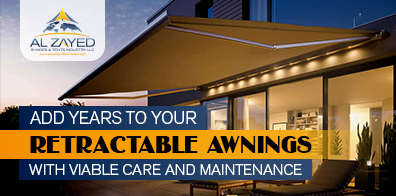
Retractable awnings or “free-standing awnings” are designed to be low maintenance and self-storing when retracted. However, despite being easy and simple to use, proper care and maintenance can add to the life of your awnings and keep them looking in mint condition!
The main purpose of retractable awnings is to protect you from the harsh and detrimental rays of the sun or even to serve as car parking shades in Dubai. They are not designed to be used in extreme weather conditions and at all times. While automatic rain, wind, or sun sensors serve to extend the convenience and comfort of your awnings, nothing can make up for the diligence and attention only you can invest in.
To enhance the durability of your retractable awnings, it is advised to turn off any automatic control systems and retract your awning when you are planning to go away for a while or when stronger than 18 mph of winds are expected. This is because such potent winds can wreak havoc on your retractable awnings. Unpredictable winds are notorious for changing their intensity and direction on the go. The downward force of the wind isn’t as big a concern as its lifting-up effect on the retractable awning. Therefore, the greater the angle from the front of the awning to the mounting height, known as the pitch, the higher the wind resistance of the awning.
In addition, you should also retract your awning when your area is expecting freezing, driving, or persistent rains, sleet, or frost, since water pooling on the fabric can lead to irreversible fabric stretching and irrevocable damages. Metal arms and bars of the awning can break or bend under the extra weight of the pooling waters. In the absence of strong winds, Awnings that have a proper pitch may be extended in misting rains. In fact, if you want to sit outside and enjoy a nice breeze or a light drizzle, you can extend your awning to an extent.
When you are facing harsh weather conditions, you can even consider removing the loose-hanging valances of your awning to make it easier to store them in winters. While awnings can be used year long, you can use a winter cover for your unit to add a layer of protection. A lot of tents and shades companies can provide you with sturdy hoods to keep your awning safe from weather elements, in the absence of a structural protection. This becomes crucial when the hood is not situated directly under an overhang or a soffit, or is fascia mounted or roof mounted.
In general, it is advised to retract your awnings when you are not planning to use them for some time. Make sure to keep your awnings neat and spruced up. While most companies use a mildew resistant fabric for retractable awnings, dirt or debris accumulating on the fabric can lead to mildew damage. Keep vines and shrubbery away from your unit, since the secret acids spawned by some plants can wreak havoc on the hardware and the fabric. While awnings are unlikely to fall prey to rust, it is still wise to check for it occasionally, since rust can lead to fabric stains and deteriorate the fabric.
In addition, it isn’t prudent to extend or retract a crank operated awning by force. If your awning has been subjected to frost, let it thaw out before retracting it. Refrain from using your awning in hot temperatures or near direct flames, since smoke and grease can discolor the fabric. Keep all spot removers and strong solvents away from your awning, since they can damage the fabric. In addition, using pesticides on the awning can cause staining and impair its water repellency.
In addition, springs and moving parts may be prone to creaking if they hadn’t been used for a while, especially in chilly weather conditions. You can apply a coat of a silicon spray lubricant to eliminate any annoying whines from the moving parts and get them to move smoothly.
Following a regular cleaning routine on your retractable awnings can extend their service life and their durability, starting from the first year that you get one installed. Rinse your awning about once a month with a garden hose, making sure to keep water away from the motor. Before you retract the awning, make sure that the awning has been cleaned. The underside of the awning can be cleaned with the help of a sanitary household broom, while a dry, stiff brush can be used to remove all dirt and debris. Regular maintenance comes down to a thorough yearly cleaning regime, taking extra care to deal with soiling and stains.
It is prudent to consult a car parking shades in Dubai Company to glean insights on proper cleaning instructions before you get down to cleaning the fabric. Persistent marks can be removed with the help of a non-bleach, non-detergent, mild soapy solution. Make sure to rinse thoroughly afterward, since any leftover solution can leave off a chalky residue and marks. An approved conditioning solution is leveraged to recondition waterproofing or fabric finish.